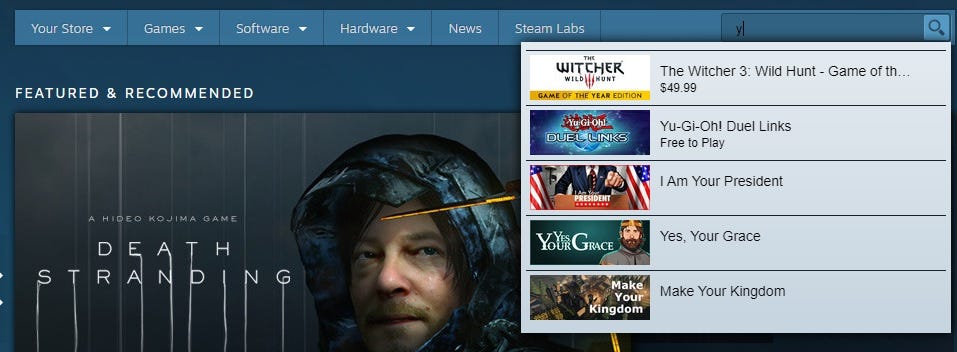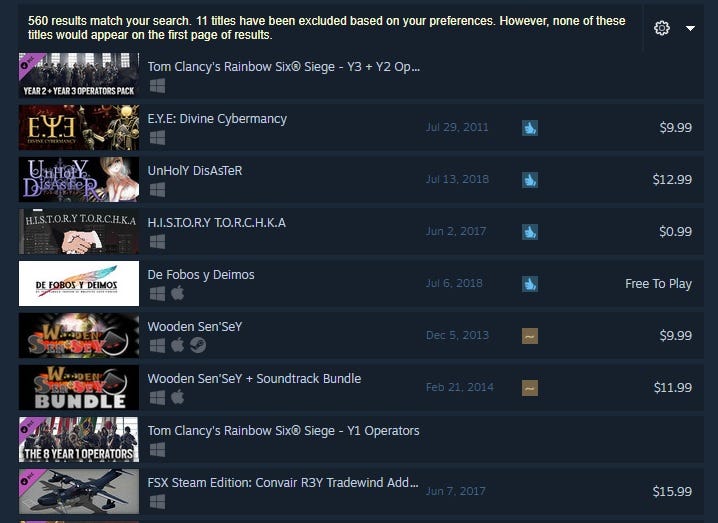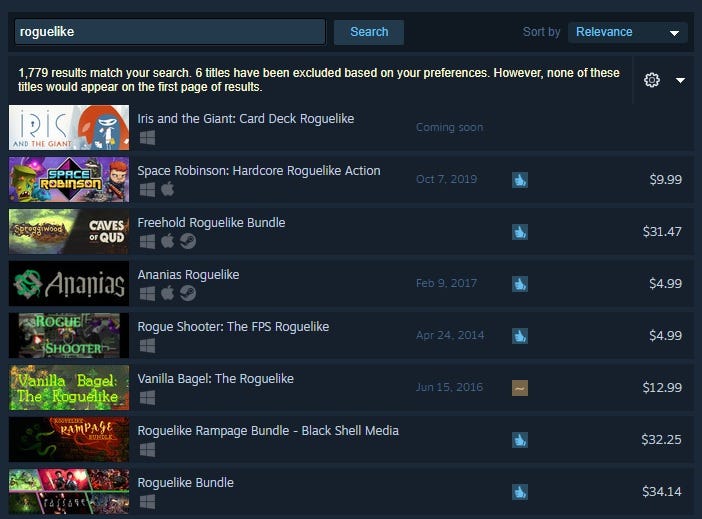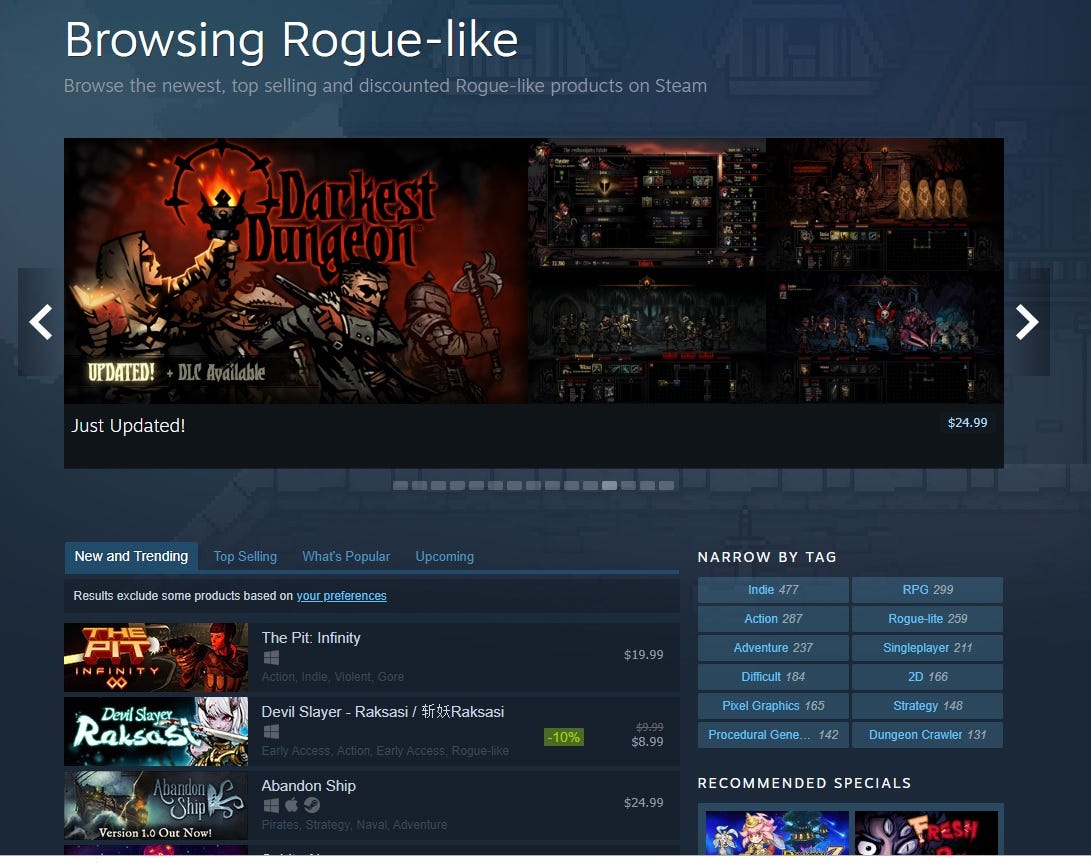Steam search suggestions & premium positioning
Magnets (OK, search suggestions) - how do they work?
[Hi, I’m Simon Carless, and you’re reading Game Discoverability Now!, a regular look at how people find - and buy - your video games. Or don’t. You may know me from helping to run GDC & the Independent Games Festival, and advising indie publisher No More Robots, or from my other newsletter Video Game Deep Cuts.]
So we’re going to have another ‘game sales analysis’ newsletter next time out. It’s for a title that also launched on iOS and Android as well as Steam, actually, so that should be entertaining! But this time, I thought it would be interesting to look - incredibly specifically - at Steam search suggestions. That is, the games that pop up when you start typing in things in Steam search.
(BTW, it’s interesting that ‘discoverability’ discussion on Steam tends to focus more around features and ‘You Might Like’ recommendations, rather than search/SEO. But that may be for a reason.)
Here’s an example revolving around Yes, Your Grace, the No More Robots-published ‘kingdom intrigue simulator’ which Mike Rose notes on Twitter has been doing really well for Steam discoverability since its recent announce.
With regard to search and Yes, Your Grace, here’s what happens if I type ‘Yes’ in the search bar on the non-logged in web version of the Steam store:

That’s great, actually - top result!
And then here’s what I see if i type in ‘Ye’. No sign of Kanye here, disappointingly, though the ‘Game Of The YEAR’ edition of The Witcher 3 is added to the mix:

And here’s what happens if you just type ‘Y’ - and yep, Yes, Your Grace is STILL in the top 5 results, that’s good news for the devs:

But overall, clearly this ‘suggest a game’ popup plays in the game’s favor. I don’t think it’s a major part of of the discoverability advantage of games, but it certainly doesn’t hurt.
(BTW, I need to get access to more of the No More Robots Steam back-end to research overall store page referrals more, haha. I may do an additional column when I do - this blog is definitely based on public-facing results only.)
But how do you get in the search suggestions? Yes Your Grace doesn’t come out until early 2020, but you can see from searching in Steam Groups that it has about 2,100 followers already - which is pretty good, actually.
So I believe it’s either got enough wishlists - or is accumulating them at a swift enough rate - that it’s getting better placement in search results.
(Side note: besides the game being really neat-looking and having a good hook, some early YouTuber playthroughs have really helped interest in Yes, Your Grace. It’s a little unorthodox allowing YouTubers to play your game months before it comes out. But maybe it’s a good idea if it helps with wishlists early on, and therefore Steam discoverability enhancements pre-release?)
Overall, if you look at the other unreleased games on the ‘Y’ results suggestions (3 out of the 5 didn’t come out yet!), you’ll see some other lower-profile games that are accumulating a pretty impressive amount of followers, and likely wishlists.
On the ‘suggested search results’ list, you may not have been paying attention to I Am Your President (published by PlayWay, the House Flipper and Car Mechanic Simulator publisher!), but it looks like it’s doing well - 12,500 followers, so probably approaching 100,000 wishlists! Don’t say it’s a ‘surprise hit’ when it comes out and does well…

And secondly, there’s Make Your Kingdom, which is has 7,500 followers - so probably >50k wishlists, and a solid mid-level hit when it comes out - unless it craters after release.
It’s a ‘low poly town building game’ - and looks like exactly the type of genre I would expect to be a hit. Yet I totally hadn’t heard of it. Everyone needs to pay more attention to follower counts around here. (These are NOT ‘hot on Twitter/hot in dev circles’ games.)

Pretty interesting to see what pops up, even for that small cross-section of results, right?
[ADDENDUM ON FOLLOWER RATIOS: with the data available to me, the Steam follower to wishlist balance ratios for both unreleased AND released games seem to be are anywhere from 1:5 to 1:10. So wishlist balance numbers are anywhere from 5x to 10x follower numbers. Please ping me if you see any significant outliers from that.
Essentially, a follow is a ‘lite’ wishlist and only done by a minority of those interested in the game. But it’s actually public data on Steam, unlike wishlists! See my earlier column for more info on this.]
Moving on, regarding search results themselves when you click through, they stack up a little bit differently. Interestingly, when you actually search for ‘Y’, you just see games that specifically have the letter ‘Y’ isolated in some way in its title (with some weird exceptions like capital letters next to lower-case letters or numbers):

In some ways, the actual Steam search results are fairly rudimentary. Here’s a good example for roguelike, which doesn’t really try to search by genre or tag at all, but simply includes anything with that string in the title:

That’s probably not what people are really looking like if they search for that - they’re probably really looking for the user tag ‘Rogue-like’:

The user tag system is a whole other ball o’ wax. And in Steam’s defense, if you search on Google for ‘Steam roguelike’, it does bring up the tags page and not the search results page. But yes.. parallel systems here for navigation, both co-existing on the site.
So search suggestions - hot and predictive. Search results - extremely literal. Tag browsing - pretty cool actually, especially since the tags are user-added. That’s your trifecta of search/browse related Steam methodologies!
[BTW, I’ve also seen some indications that these ‘search suggestions’ results aren’t 100% reproduce-able. I wonder if they vary per territory? I don’t THINK they vary per logged-in user. Any additional information on this would be useful.]
So overall, this is just some musings on the kind of games that are racking up decent wishlists - and likely eventually decent sales on Steam, and how they are appearing in search suggestions.
It’s an interesting corner of the Steam ecosystem. But understanding ‘natural’ discoverability more is the next step. Hopefully I’ll get to that in a couple of columns’ time!
Take care,
Simon.
